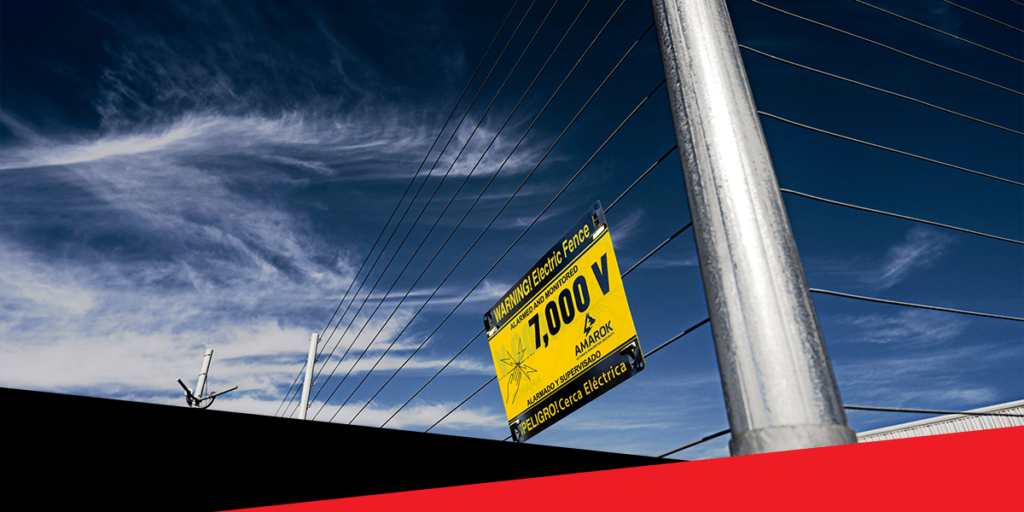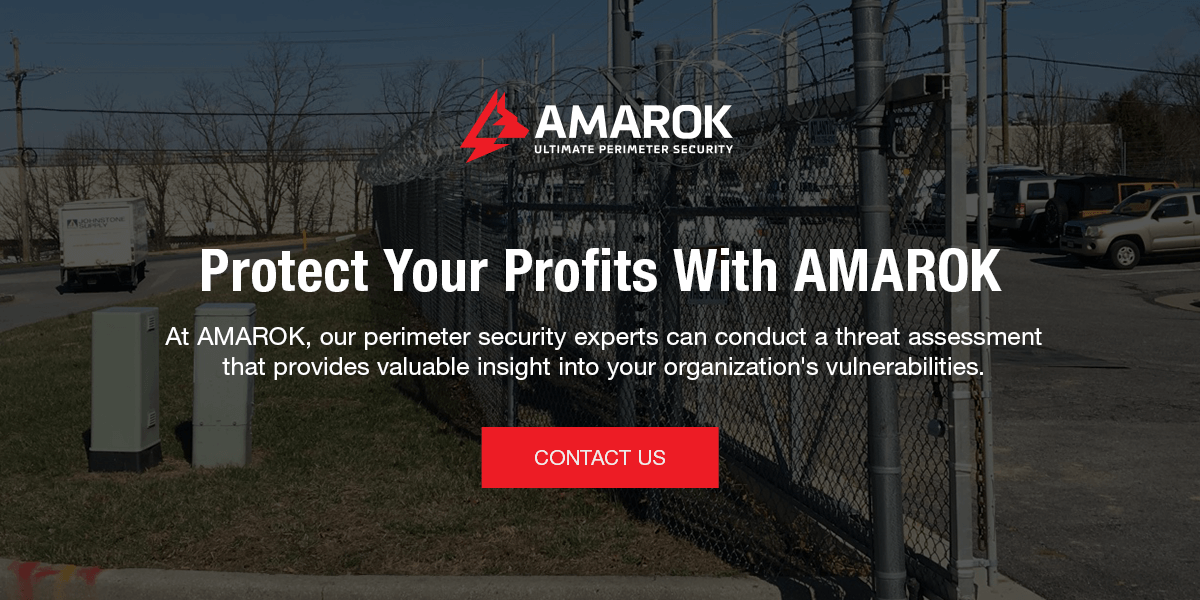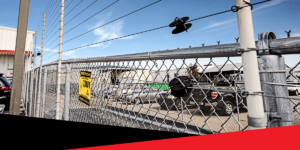The scrap metal theft problem is becoming a growing concern for businesses across various industries. As scrap metal prices rise and supply chain shortages become apparent, thieves see opportunities for their own gain. This trend poses significant risks, including financial loss, increased crime rates, and safety hazards for communities, employees, and organizations alike.
Scrap metal theft impacts a company’s bottom line and can disrupt operations, leading to expensive repairs and compromising site safety. To safeguard profits and protect assets, it is crucial that organizations implement comprehensive security strategies that deter theft, enable rapid detection, and ensure swift response. From assessing risk to implementing multi-layered security solutions, there are several steps your business can take to safeguard profits against this costly threat.
Understanding Scrap Metal Theft
Scrap metal theft involves stealing valuable metals like aluminum — which saw an average price of $2,256 per metric ton in 2023 — as well as copper and steel, which are then sold for profit. Copper is almost priced 30% higher than it was five years ago, and steel prices reached record highs in the years following the pandemic.
Organizations vulnerable to scrap metal theft include:
- Recycling yards
- Automotive dismantling and restoration businesses
- Utility companies
- Construction sites
- Manufacturing industries
- Warehouses and distribution centers
- Scrap metal dealers
In construction, scrap metal theft often results in the loss of copper wiring, pipes, and other building materials, which leads to inflated overheads and disrupted project timelines. Thieves may attempt to breach warehouses to access storage areas or loading docks, taking anything from metal pallets to wiring from essential machinery. For the trucking industry, scrap metal theft includes stripping vehicles and trailers of parts like catalytic converters containing precious metals like palladium and platinum.
The Importance of Preventing Scrap Metal Theft
Preventing scrap metal theft is essential for protecting assets and ensuring employee and community safety. Proactive, strategic security measures must be in place to deter potential thieves, secure your premises, and respond to attempted breaches. Comprehensive security solutions serve as both a deterrent and a safeguard, helping businesses mitigate losses and operate safely and efficiently.
Cost to Businesses
Preventing scrap metal theft is critical for both economic and public safety reasons. For businesses, the financial impact goes beyond immediate material loss. Replacing stolen metal can be costly, especially for high-value metals like aluminum and copper. Theft can also lead to operational delays and lost revenue due to downtime.
The delays that can ensue from these incidents can cascade into further financial losses and strained client relationships. Scrap metal theft results in material loss and can compromise site safety and security, increase insurance premiums, and necessitate costly repairs, adding another layer of financial strain.
Beyond the monetary impact, scrap metal theft can create safety hazards, especially if thieves tamper with electrical systems and other critical components. As a result, businesses in these sectors are turning to various solutions to deter potential theft and protect their assets.
Public Safety
The impact of scrap metal theft extends far beyond individual businesses. It affects the local economic stability, safety, and overall quality of life for the public. Stolen metal can include materials essential to infrastructure, like piping, wiring, or components from vehicles or equipment. When thieves strip these components, they often leave hazards behind, such as gas leaks, exposed wires, or structural weaknesses.
For example, when a fire hydrant is stripped, it can cost upwards of $4,500 to replace, which can deplete valuable financial resources. The community impact can be seen in the following ways:
- Higher crime rates: High levels of scrap metal theft contribute to overall crime rates, fostering insecurity among residents and businesses.
- Increased security costs: Increased investment in more stringent security measures can impact communities, raising prices for goods and services in the area.
- Economic consequences: Affected businesses may cut back on hiring, close down, or delay expansion plans, resulting in local job losses and decreased economic activity.
- Law enforcement strain: Increased theft can divert law enforcement’s attention and funding away from other community initiatives. They may allocate more resources to combat theft, which can hinder their ability to address other crimes.
- Community trust erosion: As theft increases, residents may become more suspicious of each other, breaking down cohesion and collaboration. A perceived lack of safety also hinders community engagement and participation.
- Employee safety: Proactive measures that mitigate the risk of scrap metal theft help keep criminals off business premises. The safety of employees who work for that company increases as a result.
Addressing these issues requires a collective effort from businesses, local law enforcement, and residents to implement effective prevention strategies. When companies safeguard their own operations against this threat, they are also helping their communities remain safer.
6 Tips for Stopping Scrap Metal Theft on Your Property
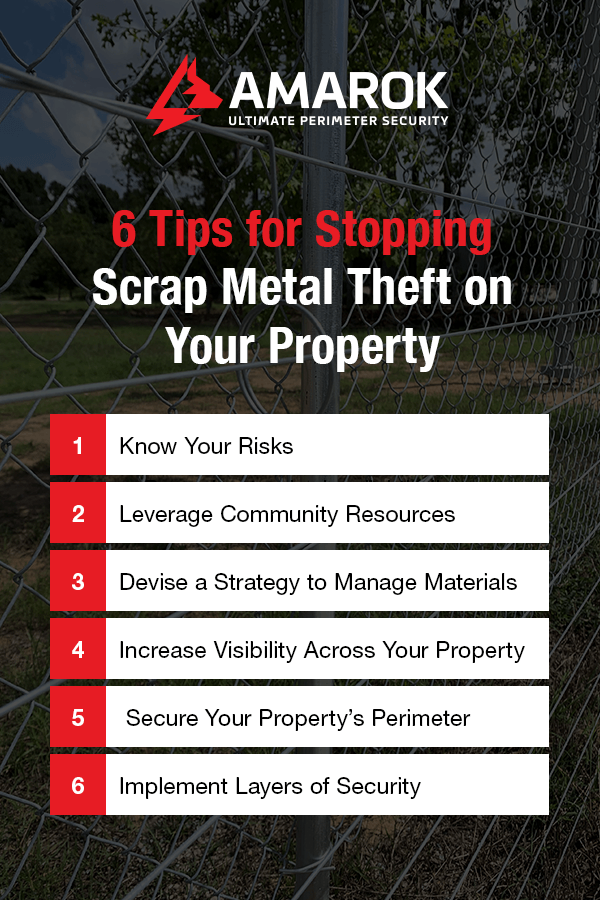
Organizations can take several proactive steps to stop scrap metal theft, focusing on deterrence, detection, and response. The best solution is to invest in a comprehensive security solution. Following these six tips can significantly reduce the risk of scrap metal theft on your property.
1. Know Your Risks
Understanding your unique risks and vulnerabilities is crucial. Knowing what puts your property at risk enables you to tailor security measures effectively, minimizing potential losses and maximizing safety. You can use this information to prioritize security investments, prevent costly incidents, and create a safer environment for your employees and assets.
Ways to conduct a threat assessment include:
- Conduct regular security audits: Periodically review current security measures to ensure they meet evolving threats. Cover perimeter defenses, access control, lighting, and surveillance systems.
- Identify high-value targets: Assess areas where scrap metal is frequently handled or stored. Look at your property layout and note accessible loading docks and poorly lit areas that can make for easy access points.
- Implement a response plan: Knowing your risks lets you develop a specific response plan should a theft attempt occur. This plan includes procedures for employees to report suspicious activities and protocols for security if a breach is detected.
- Evaluate nearby crime rates: Understanding local crime trends helps predict the likelihood of scrap metal theft on your property. High-theft areas require enhanced perimeter defenses.
- Consider the property’s traffic: When high volumes of people come and go on a property, there is an increased risk of external theft. Evaluate your gate access procedures and whether there are any vulnerabilities.
2. Leverage Community Resources
Community collaboration can strengthen security efforts. It is a powerful yet often overlooked strategy for enhancing your business security. By tapping into these local connections, your company can create a stronger, more resilient defense system that works beyond your property lines:
- Relationships with local law enforcement: Establish a direct line of communication with local police departments and neighborhood patrols. Request for regular patrols in the area, especially during off-hours, to increase visible deterrence.
- Join a business watch program: Coordinating with nearby businesses helps create a network that shares information on suspicious activities. This collaboration establishes a collective vigilance, making the area less appealing to thieves.
- Engage with neighborhood associations: Participating in local neighborhood watch programs can further deter theft and assist in recovering stolen goods by keeping law enforcement and community members informed.
- Stay updated with crime alerts: Sign up for local crime alert services, which send out real-time notifications about nearby criminal activity. This way, you can stay aware of potential threats and adjust your security measures accordingly.
- Partnering with scrap yards: As scrap metal is often sold locally, building relationships with those in the industry can add another layer of vigilance. They may be able to alert you if someone tries to sell suspicious materials matching your inventory.
3. Devise a Strategy to Manage Materials
Managing materials with care helps reduce the likelihood of theft and creates a more secure environment for your property. It can also streamline your operations, protect your assets, and reduce waste. This strategy is especially critical for businesses handling high-value materials, where theft and mismanagement can lead to financial loss.
Developing a strategic approach includes taking these steps:
- Implement inventory tracking: Tracking the movement and quantity of materials helps you monitor usage patterns and detect unusual discrepancies that may indicate theft. Frequent audits also help ensure inventory accuracy.
- Centralize storage areas: Keep valuable scrap metals and materials in one secure, centralized location. Consolidating materials lowers the number of vulnerable points, allowing for more focused security measures.
- Schedule routine pickups: Reducing on-site scrap accumulation through frequent pickups from a recycler lowers the incentive for theft, as there is less scrap available to steal.
- Use marking techniques: Unique identifiers like serial numbers or painted markings make stolen materials easier to identify and harder to resell, which deters potential thieves.
- Invest in secure containers: Store scrap metal in lockable bins or secure containers to prevent unauthorized access. They add a strong physical deterrent and make it clear if there’s been a breach.
- Limit material access: Restrict access to scrap materials and consider assigning specific hours for handling and moving these items. This proactive approach will make pinpointing irregular activity easier.
4. Increase Visibility Across Your Property
Enhanced visibility throughout the property, especially in low-traffic zones and near storage areas, makes it harder for thieves to operate undetected. It is a powerful deterrent against scrap metal theft and can be implemented in the following ways:
- Optimize lighting: Install high-intensity LED floodlights around the perimeter, especially near storage areas and entrances. Consistent bright lighting is a psychological deterrent and enhances the quality of surveillance footage.
- Trim vegetation: Overgrown bushes, shrubs, and trees can offer cover for intruders. Trim back vegetation regularly around fences, entry points, and storage areas. Low-profile landscaping creates an open view from all directions.
- Use reflective markers: Mark entry points, pathways, and storage areas with reflective paint or markers to improve low-light visibility. These can help security staff and employees easily spot suspicious movements.
- Elevate storage: Store high-value items off the ground or on elevated platforms to reduce potential hiding spots. It also makes it easier for security personnel and cameras to monitor materials.
- Install surveillance cameras: Place security cameras at vantage points that cover large areas with minimal blind spots. Wide-angle lenses can improve overall property visibility.
- Choose chain-link fencing: Choose fencing materials that provide a secure barrier without blocking visibility. Unobstructed views enhance the effectiveness of security systems.
5. Secure Your Property’s Perimeter
Establishing physical barriers like high-security fencing and reinforced entry points can limit unauthorized access to critical areas. Key tactics for reinforcing perimeter security include:
- Establish a boundary fence: Start perimeter security with a high, durable fence along the property’s boundary. Opt for anti-climb features, chain-link, or welded stainless steel materials to discourage access attempts.
- Install electric fencing: Electric fencing offers both a physical and psychological deterrent. These fences can integrate with monitoring systems, adding another layer of security to your existing efforts.
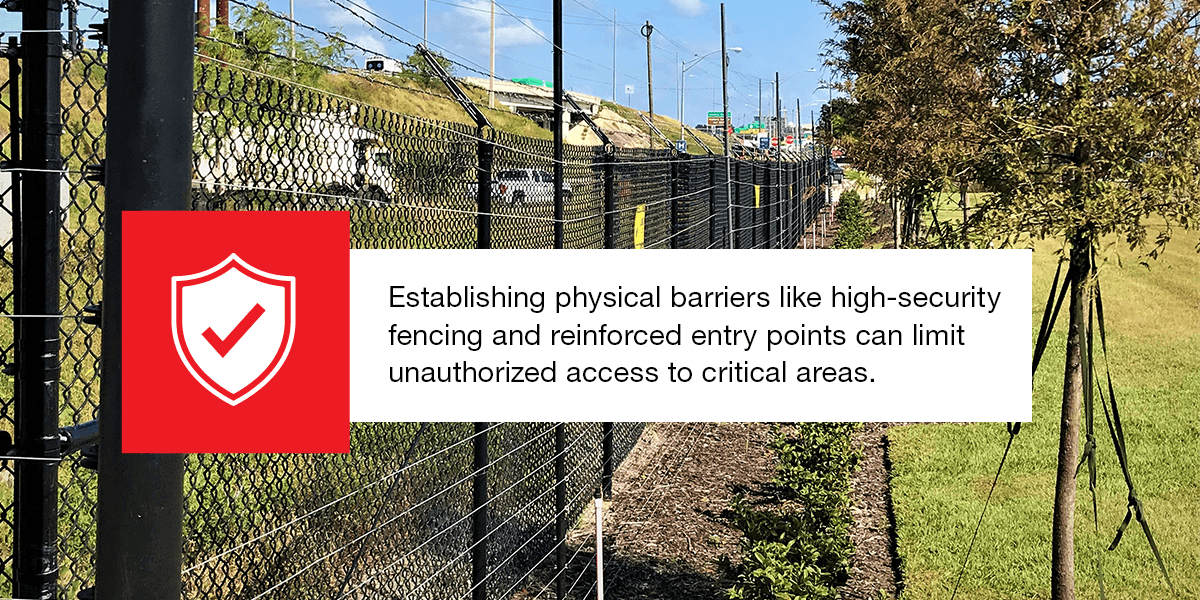
6. Implement Layers of Security
Using layers of security is essential to creating a robust defense against theft. A multi-pronged approach ensures that additional layers of security are in place to further deter and detect or delay intruders. Consider including these elements in your strategy:
- Surveillance systems: Use technology-driven solutions such as surveillance systems for real-time monitoring, allowing security teams to quickly identify suspicious activity.
- Access control: Biometric scanners or RFID badges help regulate who enters the property or sensitive areas, and generate detailed logs that assist in audits or investigations.
- Advanced detection: Consider using advanced detection systems to help detect unusual activity before a physical breach occurs. These systems can alert security personnel to concerns before they escalate.
- Security drills: Test the effectiveness of your security measures with periodic assessments and drills. These help you understand how well your systems integrate and can expose potential blind spots that may go unnoticed otherwise.
Protect Your Profits With AMAROK
Amid the rise in the theft of scrap metal, safeguarding your business requires a proactive, multi-faceted approach that includes risk assessment, leveraging community resources, and implementing a layered security system. Each element, from physical barriers and video surveillance to electric fencing that delivers a safe but memorable shock, serves as a crucial line of deterrence. Combining these strategies will help protect your assets and maintain business continuity.
At AMAROK, our perimeter security experts can conduct a threat assessment that provides valuable insight into your organization’s vulnerabilities. We can analyze your premises and offer a security solution that best fits your needs. Maintenance, repairs, and lifetime upgrades are included in a manageable monthly subscription fee, so there is zero cost of ownership.
Contact us online or call (803) 786-6333 to get started. 99% of our customers report no external theft after installation.
